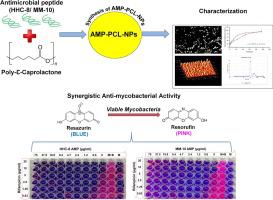International Journal of Pharmaceutics ( IF 5.3 ) Pub Date : 2021-09-14 , DOI: 10.1016/j.ijpharm.2021.121097 Ankur Sharma 1 , Aparna Gaur 2 , Vimal Kumar 2 , Neelesh Sharma 3 , Shripad A Patil 2 , Rahul Kumar Verma 1 , Amit Kumar Singh 2

|
Tuberculosis (TB) treatment has become a challenge because of the natural presence of multilayered cell wall rich in lipids which restrict antibiotic permeability within the bacteria. The development of mutations conferring resistance has aggravated the situation. Consequently, maximum pharmaceutical efforts are required to improve the treatment, and antimicrobial peptides (AMPs) with antimycobacterial activity can be exploited as a new treatment strategy against TB. The synergistic interaction between conventional antibiotics and AMPs has broadened its application landscape. To overcome peptide instability and bioavailability issues, encapsulation of these bioactive in biocompatible polymers was adopted. In this study, the effect of synthetic AMPs HHC-8 [KIWWWWRKR] and MM-10 [MLLKKLLKKM] encapsulated in poly (ε-caprolactone) nanoparticles (PCL-NPs) was evaluated against mycobacteria using REMA (Resazurin Microtiter Assay Plate) technique. PCL encapsulation allowed us to load the required amount of peptides, i.e. HHC-8 and MM-10, with an efficiency of ∼ 18.9 ± 5.24 and ∼ 21.1 ± 6.19 % respectively, and sphere size was around 376.5 ± 14.9 nm and 289.87 ± 17.98 nm for PCL-HHC-8-NPs and PCL-MM-10-NPs, respectively. Minimal degradation and sustained release of peptides from nanoparticles improved antimicrobial activity, decreasing the MIC50 from 75 µg/ml to 18.75 µg/ml against M. smegmatis and from 75 µg/ml to 9 µg/ml against M. tuberculosis, respectively. The combinatorial MIC assays of encapsulated AMP with rifampicin antibiotics against M. smegmatis showed synergism between AMP-PCL-NPs and antibiotics with fractional inhibitory concentrations (FICs) around ∼ 0.09. The combinations of AMP NPs also demonstrated synergy against the mycobacteria. Our findings suggest that enhanced efficacy is due to protection offered by AMPs encapsulation resulting in augmentation of membrane permeation by AMPs and enhanced accumulation of antibiotics within mycobacteria resulting in synergy. The study findings might assist in the preclinical development of AMP for the fight against TB.
中文翻译:

负载在聚-己内酯纳米颗粒中的合成抗菌肽对分枝杆菌的抗菌活性及其与利福平的功能协同作用
结核病 (TB) 治疗已成为一项挑战,因为天然存在的富含脂质的多层细胞壁限制了细菌内的抗生素渗透性。赋予抗性的突变的发展加剧了这种情况。因此,需要最大的制药努力来改善治疗,并且可以利用具有抗分枝杆菌活性的抗菌肽 (AMP) 作为抗结核的新治疗策略。常规抗生素与 AMP 之间的协同作用拓宽了其应用领域。为了克服肽的不稳定性和生物利用度问题,采用了将这些生物活性物质封装在生物相容性聚合物中。在这项研究中,使用 REMA(刃天青微量滴定板)技术评估了包裹在聚(ε-己内酯)纳米颗粒 (PCL-NPs) 中的合成 AMPs HHC-8 [KIWWWWRKR] 和 MM-10 [MLLKKLLKKM] 对分枝杆菌的影响。PCL 封装使我们能够加载所需数量的肽,即 HHC-8 和 MM-10,效率分别为 ~ 18.9 ± 5.24 和 ~ 21.1 ± 6.19 %,球体大小约为 376.5 ± 14.9 nm 和 289.87 ± 17。分别为 PCL-HHC-8-NPs 和 PCL-MM-10-NPs 的 nm。纳米颗粒中肽的最小降解和持续释放提高了抗菌活性,降低了 MIC 分别为 1 ± 6.19 %,PCL-HHC-8-NPs 和 PCL-MM-10-NPs 的球体尺寸分别约为 376.5 ± 14.9 nm 和 289.87 ± 17.98 nm。纳米颗粒中肽的最小降解和持续释放提高了抗菌活性,降低了 MIC 分别为 1 ± 6.19 %,PCL-HHC-8-NPs 和 PCL-MM-10-NPs 的球体尺寸分别约为 376.5 ± 14.9 nm 和 289.87 ± 17.98 nm。纳米颗粒中肽的最小降解和持续释放提高了抗菌活性,降低了 MIC50 分别从 75 µg/ml 到 18.75 µg/ml 对抗耻垢分枝杆菌,从 75 µg/ml 到 9 µg/ml 对抗结核分枝杆菌。包封的 AMP 与利福平抗生素对耻垢分枝杆菌的组合 MIC 测定显示 AMP-PCL-NP 与部分抑制浓度 (FIC) 约为 0.09 的抗生素之间具有协同作用。AMP NPs 的组合也表现出对分枝杆菌的协同作用。我们的研究结果表明,增强的功效是由于 AMPs 封装提供的保护导致 AMPs 的膜渗透增强和分枝杆菌内抗生素的增强积累,从而产生协同作用。研究结果可能有助于 AMP 抗击结核病的临床前开发。











































 京公网安备 11010802027423号
京公网安备 11010802027423号